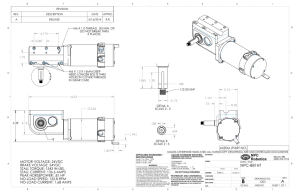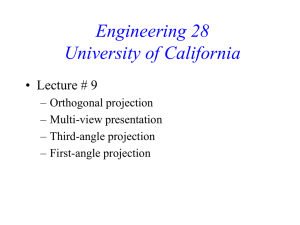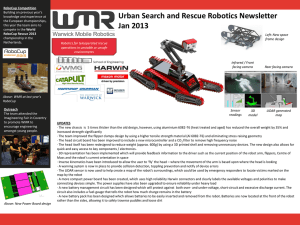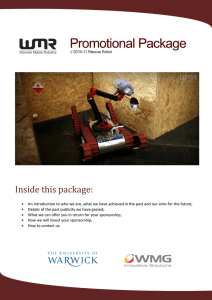Target Tracking and Predictive Control Using Rfid for Mobile Robot
advertisement
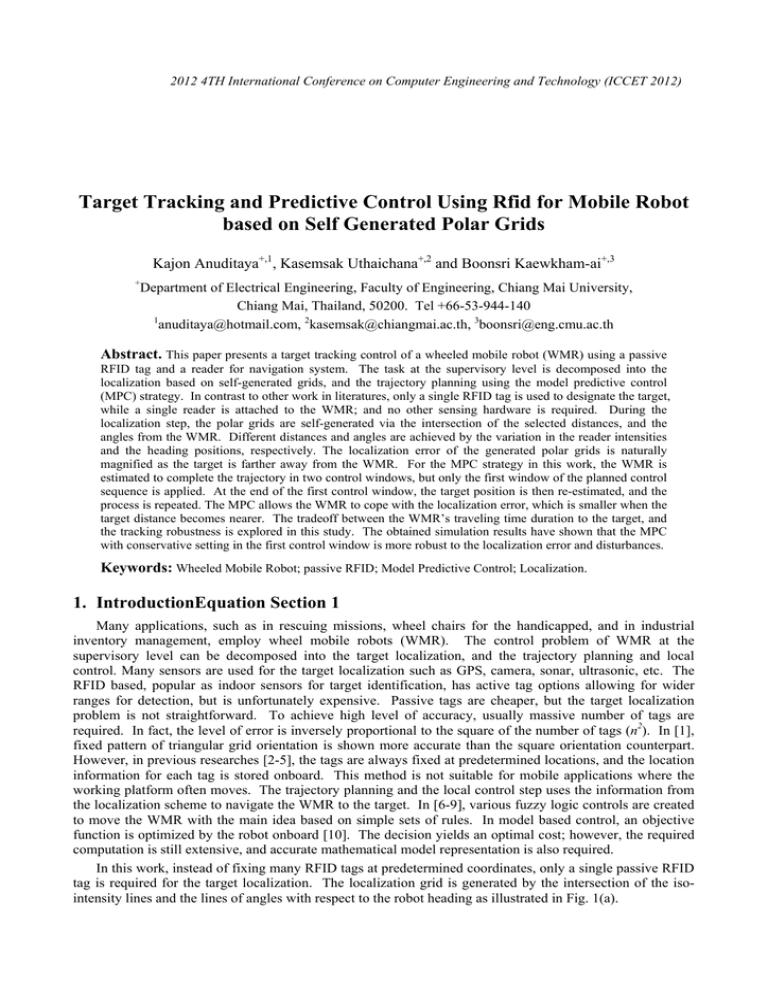
2012 4TH International Conference on Computer Engineering and Technology (ICCET 2012)
Target Tracking and Predictive Control Using Rfid for Mobile Robot
based on Self Generated Polar Grids
Kajon Anuditaya+,1, Kasemsak Uthaichana+,2 and Boonsri Kaewkham-ai+,3
+
Department of Electrical Engineering, Faculty of Engineering, Chiang Mai University,
Chiang Mai, Thailand, 50200. Tel +66-53-944-140
1
anuditaya@hotmail.com, 2kasemsak@chiangmai.ac.th, 3boonsri@eng.cmu.ac.th
Abstract. This paper presents a target tracking control of a wheeled mobile robot (WMR) using a passive
RFID tag and a reader for navigation system. The task at the supervisory level is decomposed into the
localization based on self-generated grids, and the trajectory planning using the model predictive control
(MPC) strategy. In contrast to other work in literatures, only a single RFID tag is used to designate the target,
while a single reader is attached to the WMR; and no other sensing hardware is required. During the
localization step, the polar grids are self-generated via the intersection of the selected distances, and the
angles from the WMR. Different distances and angles are achieved by the variation in the reader intensities
and the heading positions, respectively. The localization error of the generated polar grids is naturally
magnified as the target is farther away from the WMR. For the MPC strategy in this work, the WMR is
estimated to complete the trajectory in two control windows, but only the first window of the planned control
sequence is applied. At the end of the first control window, the target position is then re-estimated, and the
process is repeated. The MPC allows the WMR to cope with the localization error, which is smaller when the
target distance becomes nearer. The tradeoff between the WMR’s traveling time duration to the target, and
the tracking robustness is explored in this study. The obtained simulation results have shown that the MPC
with conservative setting in the first control window is more robust to the localization error and disturbances.
Keywords: Wheeled Mobile Robot; passive RFID; Model Predictive Control; Localization.
1. IntroductionEquation Section 1
Many applications, such as in rescuing missions, wheel chairs for the handicapped, and in industrial
inventory management, employ wheel mobile robots (WMR). The control problem of WMR at the
supervisory level can be decomposed into the target localization, and the trajectory planning and local
control. Many sensors are used for the target localization such as GPS, camera, sonar, ultrasonic, etc. The
RFID based, popular as indoor sensors for target identification, has active tag options allowing for wider
ranges for detection, but is unfortunately expensive. Passive tags are cheaper, but the target localization
problem is not straightforward. To achieve high level of accuracy, usually massive number of tags are
required. In fact, the level of error is inversely proportional to the square of the number of tags (n2). In [1],
fixed pattern of triangular grid orientation is shown more accurate than the square orientation counterpart.
However, in previous researches [2-5], the tags are always fixed at predetermined locations, and the location
information for each tag is stored onboard. This method is not suitable for mobile applications where the
working platform often moves. The trajectory planning and the local control step uses the information from
the localization scheme to navigate the WMR to the target. In [6-9], various fuzzy logic controls are created
to move the WMR with the main idea based on simple sets of rules. In model based control, an objective
function is optimized by the robot onboard [10]. The decision yields an optimal cost; however, the required
computation is still extensive, and accurate mathematical model representation is also required.
In this work, instead of fixing many RFID tags at predetermined coordinates, only a single passive RFID
tag is required for the target localization. The localization grid is generated by the intersection of the isointensity lines and the lines of angles with respect to the robot heading as illustrated in Fig. 1(a).
(a)
90
1 1 2 .5
135
1 5 7 .5
180
400cm
6 7 .5
R F ID
R eader
G rid
45
2 2 .5
0
250cm
150cm
50cm
350cm
10cm
300cm
200cm
100cm
(b)
Fig. 1 (a) Idea of self-generated polar grids (b) Selected nominal grids
The accuracy level of the position from the localization step has the direct impact on the choice of the
trajectory planning strategy. The adopted estimated position contains small error for the target close to
WMR; however, the error becomes larger as the target is further away from the WMR’s reader. This is
directly resulted from the nature of the polar grids. The model predictive control (MPC) [11-13] has been
known to deal with the plant modeling error and disturbances such as unknown road conditions. The
trajectory is planned and the control sequence is computed based on the estimated position. However, only
the first control window is executed. Then, the process is repeated. The choice of the local closed-loop
controller, such as in [14], is then selected to propel the DC motors of the WMR at the prescribed profile.
The localization scheme is presented next section. Section 3 is the summary on the MPC and the
performance index to be optimized. Section 4 presents the results. The conclusion is given last.
2. Localization via Self-Generated Grids Equation Section (Next)
To generate the polar coordinate using a single RFID tag for the target, the reader sends the RF signal
with the intensity I r of 3, 6, 9 and 12 dB. The transmission angle θ r is also varied at 45, 90, and 135
degrees, where 90 degree is denoted the front of the WMR. For each target position, the reading result for
the pair ( I r ,θ r ) is found/not found, i.e., (1/0), by constructing the sequence of the reading, {si } , it can be
used as the IDs to represent different target positions in the working space of the WMR. An example of the
reading for all four intensity levels and three heading angles are depicted in Table 1.
Table 1. Examples of reading results for various positions
12dB
9dB
6dB
3dB
45 90 135 45 90 135 45 90 135 45 90 135
1 1
1
1 1
1
1 1
1
0 1
0
However, the limitation of this localization method is found as follows. When two different target
positions are in the same vicinity and the reading of target,{si}0 and {si}1 are the same, the WMR cannot
differentiate one target from the other. Further, let Δθt be the error in the angle, and rt be the target distance,
rt Δθ is the error of the arc length. As rt increases, this arc length also increases as well. Hence, this grey
(error) area becomes larger as the target is farther away from the WMR. A nominal grid is selected for each
area of the WMR working space for the total of 22 grids as shown in Fig. 1(b). To cope with these
characteristics of the error, the model predictive control (MPC) is adopted in this work.
3. Formulation of Model Predictive Control Problem for RFID based WMR
3.1. Brief Summary on Model Predictive Control Technique
The MPC solution strategy in this study uses a moving 2-step predictive-window with the control applied
over the first control window. In particular at a given time t = tk , the problem is solved over [tk , tk +1 , tk + 2 ] ,
where the WMR is supposed to reach the target at tk + 2 as depicted in Fig. 2(b). The resulting control at the
kth iteration is applied only over [tk , tk +1 ] to the WMR. After the control action takes place, the localization
scheme is repeated to obtain the updated estimated position at tk +1 . The new control sequence is recomputed
over [tk +1 , tk + 2 , tk +3 ] , and the process is repeated until the target is found, or other stopping criteria is met.
Other number of windows can also be used. However, increasing the number of MPC window would result
in higher computational cost.
3.2. Discrete State Equation for the RFID based WMR
For target tracking at the supervisory level, the state variables zk are taken as the relative target position
in the ( x, y ) coordinate, i.e., zk = [ xkt , ykt ]T ,which can be expressed in the polar coordinate as
[ xkt , ykt ]T = [rkt cos(θ kt ), rkt sin(θ kt )]T . The control inputs are the travelling distance, and the heading angle of the
WMR, i.e., u = [ur , uθ ]T . When the control is applied, the WMR travels in the ( x, y ) coordinate, with
respect to the WMR frame at time k, as
[ xu ,k , yu ,k ]T = [ur ,k cos(90o − uθ ,k ), ur ,k sin(90o − uθ , k )]T
(2.1)
T
The new position (discrete state equation), zk +1 = [ xk +1 , yk +1 ] is given by
xk +1 = rkt cos(θ kt ) − ur , k .cos(90o − uθ ,k )
yk +1 = rkt sin(θ kt ) − ur ,k .sin(90o − uθ ,k )
(2.2)
which can be rewritten in the polar form in eq. (2.3) and depicted in Fig. 2(a).
rkt +1 = rkt 2 + ur , k 2 − 2rkt .ur , k .cos(θ kt + uθ , k − 90o )
⎛ rkt sin(θ kt ) − ur , k .sin(90o − uθ , k ) ⎞
⎟
⎜ r t cos(θ t ) − u .cos(90o − u ) ⎟
,
θ
,
k
k
r
k
k
⎝
⎠
θ kt +1 = tan −1 ⎜
(2.3)
T arg et
rk + 2
rk +1
rk
rk +1 Δy
k +1
uθ ,k
Δxk +1
90o − uθ ,k
(a)
(b)
Fig. 2 (a) State transition from k to k+1; (b) 2-step control for WMR traveling to target at time k+2.
3.3. Performance Index Equation Section (Next)
The performance index (PI) is selected to reflect the desired behavior. Since the objective is to minimize
the error of heading position and the distance from the target, PI is chosen as,
k +2
∑
J=
j = k +1
wθ , j θt , j − 90o +
k +2
∑
j = k +1
wr , j ⋅ rt , j
(3.1)
where θt , j − 90o is the heading error from 90 deg. at the jth iteration; rt , j is the relative target position (from
the WMR); wθ , j ≥ 0 , and wr , j ≥ 0 are the appropriate weighing coefficients. The objective of the WMR is to
be within the vicinity of the target at the end of the 2nd control window (k + 2) . Note that it is not desirable to
exactly hit the target, i.e., rt ,k + 2 = 0 , as the WMR can damage the target. In this study, the WMR stops
when it arrives in the vicinity of the destination, which is set as rt < ε . Hence, the modified PI is chosen as
J=
k +2
∑
j = k +1
wθ , j θt , j − 90o +
k +2
∑
j = k +1
wr , j ⋅ rt , j ⋅ (0.5 + 0.5sgn(rt , j − ε ))
(3.2)
(3.2) is chosen to penalize the WMR position outside the ε − radius circle
The sgn function in equation
centered at the target.
4. Simulation Results Equation Section (Next)
The threshold for stopping is rt < ε , where ε = 30 cm . This boundary is shown as the circled dashedline in Fig. 4. Since the target position at the end of the first window does not have to be extremely close to
the target. The weight wr ,k +1 = 0 . This introduces the possibilities of singular solutions1 to occur. Herein,
the infinite number of solution results in the same cost. For example, let a target standing in front of the
WMR, θ t = 90o , while uθ ,k is kept at zero degree, any control sequence in equation (4.1) would result in
zero-cost function. Due to the uncertainties during the location step, the estimated target position contains
error, i.e., rkt ∈ Nl (r t ) , where Nl (r t ) denotes the neighbourhood of r t with the radius l. For the control
choice in (4.1), the applied control has the travelling distance of α ⋅ rtk . The trajectories for the α = 0.3, and
0.7 for the initial target of (150,120) cm are shown in Fig. 3. The travelling time for both cases are 60 s. and
20 s., respectively. Higher number of steps for α = 0.3 is obviously due to the shorter distance for the
applied control. In another example, with initial target of (150,50) and α = 0.5 , the MPC can reach the target
within 3 steps. However, the MPC with α = 0.7 fails to stop when being in the vicinity of the target. As
shown in Fig. 4(b), when the WMR is in the circle of the target, the angle is over 180o. Hence, with the
aggressive setting, the robustness is compromised.
[ur , k , ur ,k +1 ] = [α ⋅ rtk , (1 − α )rtk ] for α ∈ [0,1]
(4.1)
150
150
100
y
y
100
50
50
0
0
0
20
40
60
80
100
120
140
160
180
0
20
40
60
80
x
100
120
140
160
180
x
y
(a)
(b)
α
=
0.3
α
=
0.7
; (b)
Fig. 3 Trajectories for initial target of (150,120) with (a)
100
80
80
60
60
40
40
y
100
20
20
0
0
-20
-20
0
20
40
60
80
100
x
(a)
1
120
140
160
180
0
20
40
60
80
100
120
140
160
180
x
(b)
The Hamiltonians in the hybrid optimal control theory associated with this set of singular solutions are equal.
Fig. 4 Trajectories for initial target of (150,50) with (a) α = 0.5 ; (b) α = 0.7
5. Conclusions
The control of a single passive RFID based wheeled mobile robot (WMR) to reach the vicinity of the
target was shown in this paper. The localization was based on the self-generated polar grids, where the
estimation error decreased as the target distance decreased. The 2-step model predictive control was shown
to be effective in dealing with the localization error, and other uncertainties. The trade-off between the target
reaching time and the robustness was illustrated. With conservative setting for the MPC control, the WMR
was more robust, and vice versa.
6. Acknowledgement
The experiment conducted in this work was supported by a research laboratory in the department of
Electrical Engineering, Rajamangala University of Technology Lanna Chiang Rai.
7. References
[1] N. Pathanawongthum and P. Cherntanomwong, "RFID based localization techniques for indoor environment," in
International Conference on Advanced Communication Technology, ICACT, 2010, pp. 1418-1421.
[2] S. Han, H. Lim, and J. Lee, "An efficient localization scheme for a differential-driving mobile robot based on
RFID system," IEEE Transactions on Industrial Electronics, vol. 54, pp. 3362-3369, 2007.
[3] M. Kim and N. Y. Chong, "RFID-based mobile robot guidance to a stationary target," Mechatronics, vol. 17, pp.
217-229, 2007.
[4] S. Park and S. Hashimoto, "Autonomous mobile robot navigation using passive RFID in indoor environment,"
IEEE Transactions on Industrial Electronics, vol. 56, pp. 2366-2373, 2009.
[5] D. Boontrai, T. Jingwangsa, and P. Cherntanomwong, "Indoor localization technique using passive RFID tags," in
2009 9th International Symposium on Communications and Information Technology, ISCIT 2009, Icheon, 2009,
pp. 922-926.
[6] W. Li, X. Jiang, and Y. Wang, "Road recognition for vision navigation of an autonomous vehicle by fuzzy
reasoning," Fuzzy Sets and Systems, vol. 93, pp. 275-280, 1998.
[7] V. M. Peri and D. Simon, "Fuzzy logic control for an autonomous robot," in Annual Conference of the North
American Fuzzy Information Processing Society - NAFIPS, Detroit, MI, 2005, pp. 337-342.
[8] D. E. Barkana, "Evaluation of low-level controllers for an orthopedic surgery robotic system," IEEE Transactions
on Information Technology in Biomedicine, vol. 14, pp. 1128-1135, 2010.
[9] J. J. Zhan, C. H. Wu, and J. G. Juang, "Application of image process and distance computation to WMR obstacle
avoidance and parking control," in Proceedings of the 2010 5th IEEE Conference on Industrial Electronics and
Applications, ICIEA 2010, Taichung, 2010, pp. 1264-1269.
[10] S. Wei, M. Zefran, K. Uthaichana, and R. DeCarlo, "Hybrid model predictive control for stabilization of wheeled
mobile robots subject to wheel slippage," in Proceedings of the IEEE International Conference on Robotics and
Automation, Rome, 2007, pp. 2373-2378.
[11] J.-S. Kim, T.-W. Yoon, A. Jadbabaie, and C. De Persis, "Input-to-state stable finite horizon MPC for neutrally
stable linear discrete-time systems with input constraints," Systems & Control Letters, vol. 55, pp. 293-303, 2006.
[12] J. Mattingley, W. Yang, and S. Boyd, "Receding Horizon Control," Control Systems, IEEE, vol. 31, pp. 52-65,
2011.
[13] K. Uthaichana, S. Bengea, R. DeCarlo, S. Pekarek, and M. Zefran, "Hybrid Optimal Theory and Predictive
Control for Power Management in Hybrid Electric Vehicle," Journal of Nonlinear Systems and Applications, vol.
2, pp. 96-110, 2011.
[14] M. B. B. Sharifian, R.Rahnavard, and H.Delavari, "Velocity Control of DC Motor Based Intelligent methods and
Optimal Integral State Feedback Controller," International Journal of Computer Theory and Engineering, vol. 1,
pp. 81-84, 2009.

